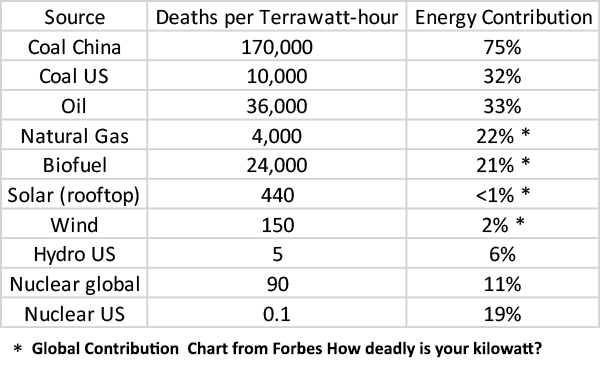Mountaintops have been pushed into neighboring valleys; rivers have been made unswimmable and unfishable to get at the coal seams beneath. The fallout from coal-fired power plants has made other lakes and ponds lifeless. My Master’s advisor and one member of my doctoral committee studied the effects of acid mine drainage – both taught me about the damage it wreaked on the affected valleys and waterways. When I lived in San Diego, it was a rare day that we could see offshore islands clearly; at times, the layer of smog was so thick that the sun set into a layer of haze rather than the sea.
Combustion
A large part of the problem is that so much of our power comes from burning things for fuel - the same process that our distant ancestors used. Just as they learned to burn wood, we now burn coal, oil, and natural gas to power our cities, cars, and trucks; and still more to heat our homes. Burning things requires a lot of fuel, which we must find and recover; it produces smoke and ash, which we breathe and must bury, all while pumping carbon dioxide and other greenhouse gases into the atmosphere that accelerate global warming. We have found more efficient ways to burn fuel, but fundamentally, we use the same processes used by the cavemen.
Nuclear energy is not a cure
But it is a fundamentally different way to produce power - one that finally breaks our practice of burning fuel. Nuclear power plants produce energy without the smoke that blocks the sunset, without the need to tear the tops off the mountains, and without the need to depend on someone else for our energy. Nuclear power can be used to help make hydrogen or electricity to power the cars our children and grandchildren will drive; nuclear power can help to make the world far safer than it is today; without the environmental degradation that accompanies the recovery and use of coal and oil.
“There is no doubt that nuclear power has problems that can cost human lives, but such risks are borne by all major modes of energy production. … ‘is nuclear energy more dangerous than other energy sources?’” Reconsidering the Risks of Nuclear Power
Having spent eight years in the Navy’s Nuclear Power Program and several years working with “roughnecks” and drillers, I was surprised when I found out that nuclear energy causes fewer deaths per Terrawatt-hour of energy produced than any other form of energy. [1] I wasn’t surprised that nuclear is safer than coal; we should all be familiar with black-lung disease among miners, not to mention the mining disasters we have all heard about. And talking with the roughnecks, I heard enough stories about the dangers of working in the oil fields and  refineries to know that natural gas and fuel oil are no more benign than is coal. But even when we add in the short- and long-term effects from reactor accidents, nuclear energy is far safer than virtually any other form of energy, and it’s certainly safer than the ones that are reliable enough to count on for baseline power production.
refineries to know that natural gas and fuel oil are no more benign than is coal. But even when we add in the short- and long-term effects from reactor accidents, nuclear energy is far safer than virtually any other form of energy, and it’s certainly safer than the ones that are reliable enough to count on for baseline power production.
Interestingly, nuclear energy also produces less radiation dose to the public than fossil fuels – primarily because of the geochemistry of uranium, which causes it to accumulate in coal, petroleum, and natural gas deposits. That’s what I was doing in North Dakota with the roughnecks and drillers, helping to find ways of characterizing radioactivity in oilfield waste. Fossil fuels (especially coal) are associated with elevated levels of NORM (Naturally Occurring Radioactive Materials), and many of the wastes produced from hydrocarbon recovery as well as the fly ash from coal combustion contain enough radioactivity to warrant surveying for radioactivity to determine whether or not they require disposal as radioactive materials [2]
Most radioactive waste, regardless of where it is produced, is not very threatening – I created thousands of cubic feet of radioactive waste in my work; primarily paper towels, test tubes, contaminated hand tools, and so forth – much of this was about as radioactive as a bunch of bananas. But some radioactive waste is potentially more dangerous – spent fuel and ion exchange resins come to mind.
I have to say that many who protest these materials are somewhat disingenuous in their objections. With spent fuel, all of the short-lived isotopes decay away within a few years – the long-lived nuclides that will be around for millennia constitute only a tiny fraction of the total radioactivity. By the time they remain, the fuel is hardly “dangerously radioactive” – no more than the uranium minerals or thoriated welding electrodes I use when I teach are dangerous. When it comes to radiation and radioactivity, there is a huge difference between “detectable” and “dangerous.” There’s more to be said about the waste from nuclear reactors, but to do it justice will require more space than I have here – so let’s save an in-depth treatment for another day!
Unlike solar, wind, tidal, geothermal, and other forms of energy, nuclear power plants can be built just about anywhere, and they can work all day, every day, year-round. Nuclear power plants are more able to provide energy “on-demand” than most other forms of energy.
Nuclear energy is not a cure-all, but if we really care about the damages to our environment, we have to realize that continuing what we are doing - burning coal, gas, and oil - will cause still more damage. I want my kids and their children to be able to enjoy the same vistas, mountain and forest hikes, and the same sunsets I enjoyed. Nuclear energy is one way to preserve our environment and pay it forward to our children.
[1] A Terrawatt is 1 trillion watts of energy or about 1.3 trillion horsepower or 950 million BTUs of heat.
[2] Fly ash is exempt from this requirement, even though it also frequently contains elevated levels of radioactivity.



